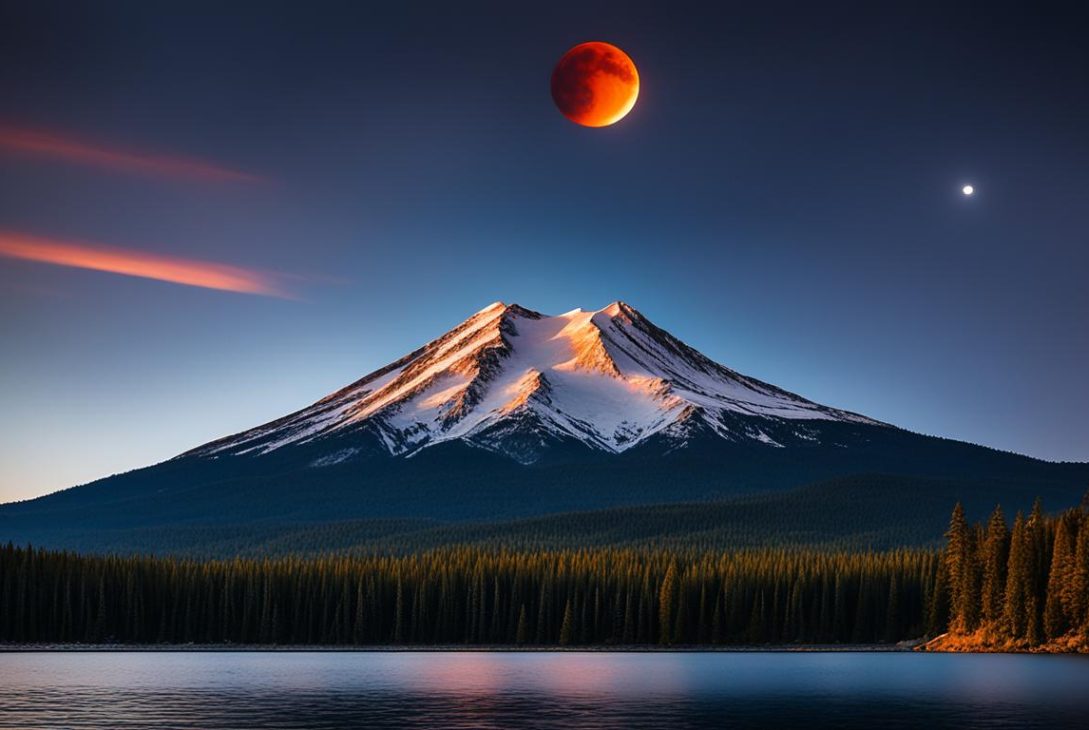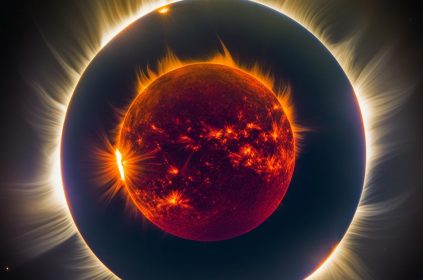On April 8, 2024, get ready to witness a rare celestial event – a total solar eclipse. This extraordinary phenomenon will be visible in North America, passing over Mexico, the United States, and Canada. As the Moon aligns perfectly with the Sun and blocks its light, the sky will darken, creating a captivating experience for observers. Don’t miss this opportunity to marvel at the wonders of the universe.
Download Detailed Map from NASA
Key Takeaways:
- The April 8th, 2024 total solar eclipse is a rare and awe-inspiring event.
- The eclipse will be visible in North America, passing over Mexico, the United States, and Canada.
- During a total solar eclipse, the Moon completely blocks the face of the Sun, creating a darkened sky.
- It is important to have proper equipment, such as certified eclipse glasses, to safely view the eclipse.
- Choose a comfortable viewing location with an unobstructed view of the sky to maximize your eclipse experience.
Understanding a Total Solar Eclipse
A total solar eclipse is a rare and extraordinary celestial event that occurs when the Moon aligns perfectly with the Sun, blocking its light from reaching the Earth. This alignment creates a captivating phenomenon where the sky darkens, and the stars may become visible. The total solar eclipse typically lasts for a few minutes, but its impact leaves a lasting impression on observers.
During a total solar eclipse, the Moon’s shadow, known as the umbra, moves along a specific path across the Earth’s surface. Anyone within this path will witness the complete obscuration of the Sun, a truly awe-inspiring experience.
It is crucial to understand the science behind a total solar eclipse to appreciate the magnitude of this event. The alignment of the Earth, Moon, and Sun during an eclipse provides a unique opportunity to study our solar system and gain insight into the mechanics of celestial bodies and their interactions.
When the Moon aligns precisely with the Sun, its apparent size matches that of the Sun, resulting in the complete blockage of sunlight. This alignment occurs because the Moon orbits the Earth in a slightly elliptical path, causing it to move closer and farther from the Earth at different times.
During the eclipse, the Moon’s shadow casts a cone-shaped region of darkness onto the Earth. This shadow consists of two parts: the inner dark core called the umbra and the outer lighter region known as the penumbra. Those located within the umbra will experience the total eclipse, while those in the penumbra will observe a partial eclipse.
As the Moon passes in front of the Sun, the sudden decrease in sunlight can have several intriguing effects. The temperature drops, animals may behave unusually, and the landscape takes on an eerie twilight appearance. The stars and planets that are usually hidden by the Sun’s bright light become visible, adding to the awe and wonder of this celestial phenomenon.
To visualize the alignment and movement of the Earth, Moon, and Sun during a total solar eclipse, refer to the diagram below:
A diagram showing the alignment and movement of the Earth, Moon, and Sun during a total solar eclipse.
A total solar eclipse provides a rare opportunity for scientists, astronomers, and enthusiasts to study the Sun’s corona, which is the outermost layer of the Sun’s atmosphere. The corona is typically hidden by the Sun’s bright disk but becomes visible during the few precious moments of totality.
“The beauty and grandeur of a total solar eclipse cannot be adequately described; it must be experienced.”
The next section will guide you in preparing for the upcoming total solar eclipse on April 8th, 2024, ensuring a safe and memorable experience.
Preparation for the April 8th Eclipse
To prepare for the April 8th eclipse, it is crucial to have the proper equipment. Eclipse glasses are essential for safely viewing the eclipse without damaging your eyes. Only use glasses that meet the ISO 12312-2 safety standard and have the approved certification mark. Ensure that you have a comfortable viewing location with an unobstructed view of the sky. Plan ahead to avoid any last-minute complications.
Finding the Best Viewing Locations
To make the most of the April 8th eclipse, it is important to find the best viewing locations. Consult online resources or local astronomy clubs to identify areas along the eclipse path where you can witness the total eclipse. Some popular viewing locations may include national parks, open fields, or elevated areas with uninterrupted views. Consider factors such as accessibility, weather conditions, and crowd management when choosing a viewing spot.
If you want to be in the heart of the action, consider heading to the following top-rated viewing locations for the total eclipse:
| Location | Description |
|---|---|
| Great Smoky Mountains National Park, USA | Nestled within the beautiful Appalachian Mountains, this national park offers breathtaking scenery and a chance to witness the eclipse against a backdrop of lush forests and rolling hills. |
| Toronto, Canada | As one of the major cities along the eclipse path, Toronto provides urban dwellers with an opportunity to experience the wonders of a total solar eclipse without venturing too far from home. |
| Teotihuacan, Mexico | Step back in time at the ancient city of Teotihuacan, where you can witness the eclipse in the shadow of the majestic Pyramid of the Sun. |
| Bryce Canyon National Park, USA | Gaze up at the stunning rock formations and vibrant hoodoos of Bryce Canyon as the eclipse casts an ethereal glow over this natural wonder. |
No matter where you choose to view the eclipse, ensure that you have a clear and unobstructed view of the sky. Additionally, make sure to check weather updates and plan for any necessary accommodations and transportation arrangements well in advance. By selecting the best viewing location, you’ll have the opportunity to witness this extraordinary celestial event in all its glory.
Key Highlights:
- Consult online resources or local astronomy clubs for recommended viewing locations along the eclipse path.
- Consider popular destinations such as national parks, open fields, or elevated areas.
- Ensure accessibility, favorable weather conditions, and crowd management when choosing a viewing spot.
Safety Measures During the Eclipse
While experiencing a total solar eclipse is exciting, it is vital to ensure your safety during the event. It is crucial to never look directly at the Sun without proper eye protection, even during a partial eclipse.
Here are some solar eclipse viewing tips to protect your eyes:
- Wear certified eclipse glasses: Always wear eclipse glasses that meet the ISO 12312-2 safety standard and have the approved certification mark. These glasses are specially designed to protect your eyes from the intense sunlight during the eclipse.
- Use solar filters on telescopes or cameras: If you plan to view the eclipse through a telescope or camera, make sure to use appropriate solar filters. These filters are specifically designed for solar observations and provide the necessary protection for your eyes and equipment.
- Do not rely on regular sunglasses: Regular sunglasses do not provide adequate protection for viewing the Sun during an eclipse. They cannot filter out the harmful solar radiation and can cause irreversible damage to your eyes.
- Avoid homemade filters or camera lenses: Homemade filters or camera lenses may seem like a cost-effective option, but they do not offer the necessary protection. They may not filter out the harmful radiation and can potentially cause serious eye damage.
Remember, protecting your eyes should be the top priority while viewing a solar eclipse. By following these safety measures, you can enjoy the awe-inspiring beauty of the eclipse without risking your vision.
Solar Eclipse Viewing Tips
“It is crucial to never look directly at the Sun without proper eye protection.”
| Eclipse Viewing Tips |
|---|
| Wear certified eclipse glasses |
| Use solar filters on telescopes or cameras |
| Do not rely on regular sunglasses |
| Avoid homemade filters or camera lenses |
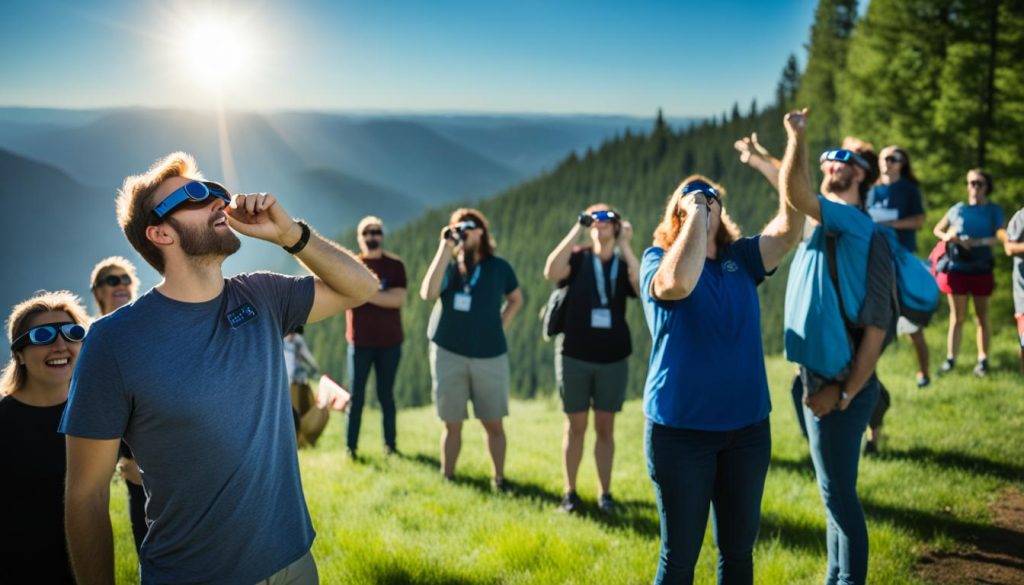
Capturing the Eclipse on Camera
The April 8th eclipse presents a fantastic opportunity for astrophotography enthusiasts. If you plan to capture the eclipse on camera, make sure you have the appropriate equipment, such as a solar filter for your lens or telescope. Practice beforehand to familiarize yourself with the settings and techniques required to photograph the eclipse effectively. Consider the eclipse path and timing to capture the most stunning images.
Photographing a solar eclipse can be a challenging but rewarding experience. To ensure you capture the eclipse in all its glory, here are some essential tips:
- Protect your eyes: Never look directly at the Sun through a camera lens or viewfinder, even during an eclipse. Wear certified eclipse glasses or use a solar filter on your camera to protect your eyes.
- Choose the right equipment: Use a DSLR camera or a mirrorless camera with manual settings. Attach a solar filter to your lens or telescope to prevent damage to your equipment.
- Plan your composition: Scout out a location with a clear view of the eclipse path. Think about including interesting foreground elements to enhance the composition of your photos.
- Practice your settings: Experiment with different camera settings before the eclipse day. Use manual mode and adjust your ISO, aperture, and shutter speed to capture the eclipse’s unique lighting conditions.
- Use a tripod: To avoid blurred images, use a sturdy tripod to keep your camera steady during the long exposures often required for capturing an eclipse.
- Consider long exposures: If you want to capture the Sun’s corona during the total eclipse phase, use longer exposure times to capture its faint light.
- Be prepared for changes in lighting: As the eclipse progresses, the lighting conditions will change rapidly. Be ready to adjust your camera settings accordingly.
Remember to enjoy the experience of viewing the eclipse with your own eyes too. While capturing photographs is important, don’t forget to take a moment to soak in the awe-inspiring beauty of this celestial event.
Weather Conditions and Backup Plans
When it comes to witnessing the upcoming total eclipse on April 8th, 2024, weather conditions play a crucial role. The visibility of a total eclipse can be affected by factors such as clouds, rain, and even haze. To ensure you have the best chance of experiencing this celestial event, it’s important to monitor the weather forecast leading up to the eclipse.
If the forecast indicates unfavorable conditions for your initial viewing location, it’s essential to have backup plans in place. Consider nearby locations that may have clearer skies, such as neighboring towns or higher elevations. By being flexible and prepared, you can maximize your chances of witnessing the eclipse and avoid disappointment.
To give yourself the best chance of enjoying the April 8th eclipse, it’s wise to plan in advance. Research potential alternative viewing locations ahead of time and familiarize yourself with their accessibility. Keep in mind that popular viewing spots may attract larger crowds, so consider lesser-known areas for a more peaceful experience.
Prepare for Uncertain Weather
While you can’t control the weather, you can be prepared for it. Here are some tips to help you make the most of the eclipse, rain or shine:
- Check multiple weather sources for accurate forecasts.
- Bring appropriate clothing and gear to stay comfortable in various weather conditions.
- Consider a mobile weather app for real-time updates on the go.
- Have a backup plan within close proximity to your original location.
Remember, a total solar eclipse is a rare event that you won’t want to miss. While weather conditions may affect visibility, there’s no harm in hoping for the best while being prepared for any outcome. Keep an eye on the forecast, stay adaptable, and make the most of this extraordinary celestial moment.
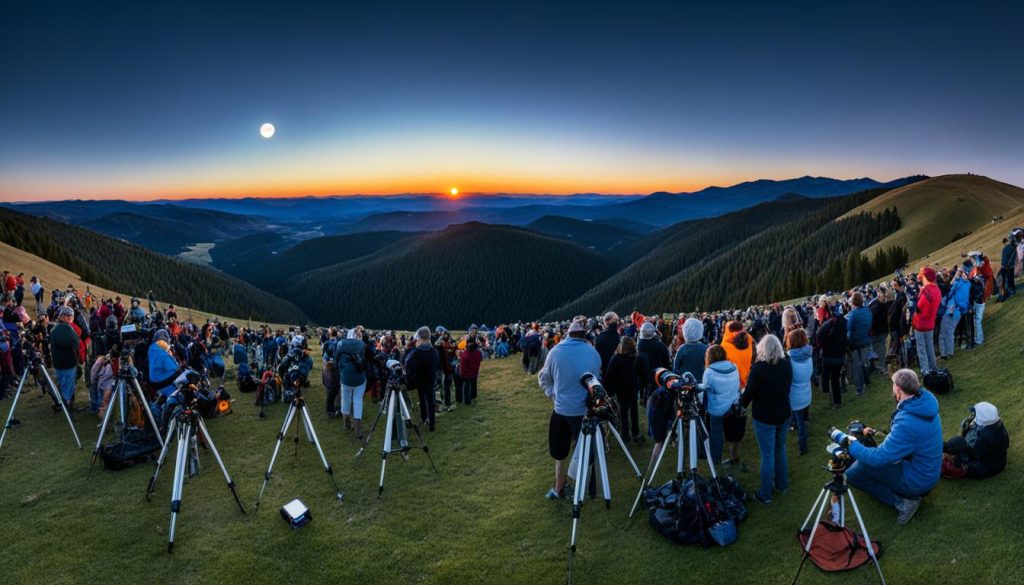
Enhancing the Eclipse Experience
To truly enhance your experience of the total solar eclipse in 2024, take the time to delve into the fascinating world of celestial events and their historical significance. By expanding your knowledge about the science behind a solar eclipse, the intricate mechanics of Earth, Moon, and Sun alignment, and the cultural significance of eclipses throughout history, you can deepen your appreciation for this awe-inspiring phenomenon.
Exploring the scientific aspects of a total solar eclipse can provide valuable insights into the mechanics of our solar system. Learn about how the Moon’s orbit aligns with the Sun and Earth, causing the Moon to cast its shadow on our planet during an eclipse. Understand the various stages of an eclipse, from partial to total, and the unique phenomena that occur during each phase.
Additionally, discovering the cultural significance of eclipses throughout history can add a layer of context and meaning to your eclipse experience. Different cultures have viewed eclipses as omens, symbols, or events of great spiritual significance. By delving into the beliefs, myths, and rituals associated with eclipses from different civilizations, you can gain a deeper understanding of the human fascination with these celestial occurrences.
“The sky is the ultimate art gallery just above us.” – Ralph Waldo Emerson
As you prepare for the 2024 celestial event, take the opportunity to share knowledge and insights with fellow eclipse enthusiasts. Engage in discussions, attend lectures, or participate in online forums dedicated to eclipses. By exchanging information and ideas, you can enrich your own understanding and contribute to the collective fascination with this natural wonder.
Remember, an eclipse is not merely a brief spectacle but a powerful reminder of the vastness and interconnectedness of our universe. By enriching your understanding of the science and history behind a total solar eclipse, you can elevate your experience and make it even more meaningful.
Notable Eclipses in History
To further immerse yourself in the world of eclipses, here are some notable examples from history:
| Eclipse | Date | Location |
|---|---|---|
| Thales Eclipse | 585 BCE | Asia Minor |
| The Einstein Eclipse | 1919 | Various locations |
| Path of Totality | 2024 | North America |
These eclipses left profound impacts on the scientific and cultural landscape, and studying them can deepen your understanding of the ongoing fascination with total solar eclipses.
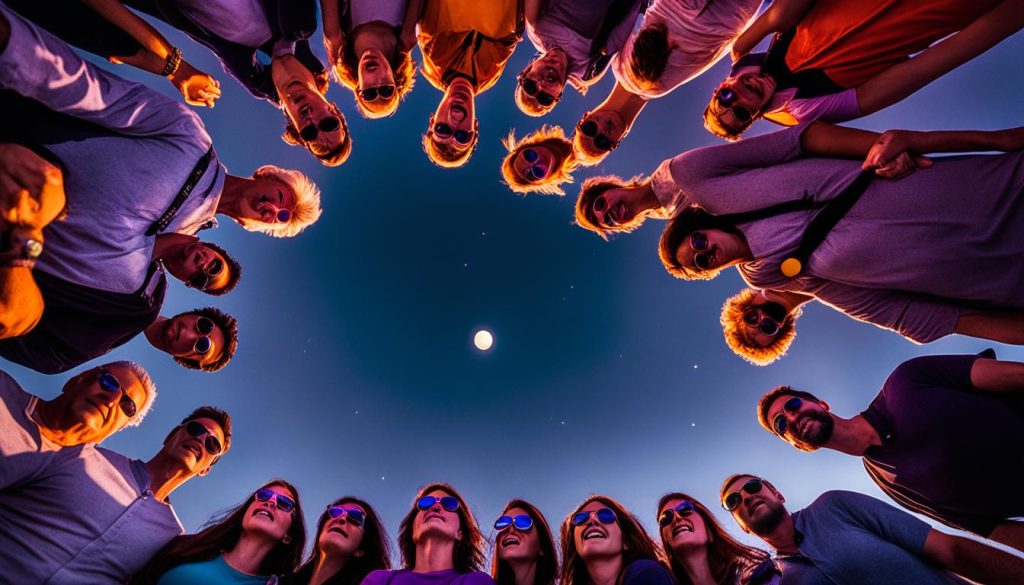
Through knowledge, curiosity, and a sense of wonder, you can truly enhance your experience of the upcoming 2024 total solar eclipse. Embrace the opportunity to explore the science and history behind this celestial event and create lasting memories of this remarkable phenomenon.
Sharing the Experience
The April 8th solar eclipse of 2024 is a truly phenomenal event that should be shared with others. Whether you’re with friends, family, or fellow astronomy enthusiasts, organizing an eclipse viewing party can be a memorable experience. By coming together, you can create a sense of community and excitement surrounding this celestial event.
Consider hosting your eclipse party at a location with a clear view of the sky, such as a local park or open field. Encourage your guests to bring eclipse glasses or provide them yourself to ensure everyone can safely observe the eclipse. Set up telescopes or binoculars with solar filters for a closer look at the Moon passing in front of the Sun.
Another option is to join local events organized by astronomy clubs or observatories. These gatherings often include expert talks, guided observations, and the opportunity to interact with fellow enthusiasts. It’s a fantastic way to immerse yourself in the world of astronomy and learn from experienced astronomers.
“Experiencing a solar eclipse with others amplifies the excitement and wonder. It’s a shared adventure that creates lasting memories and sparks curiosity about the cosmos.” – Dr. Emily White, Astronomy Educator
Collaborate with your event guests or fellow attendees to exchange knowledge and insights about the eclipse. Engage in conversations about the science behind solar eclipses, the unique features of the upcoming total eclipse, and any personal experiences or stories related to previous eclipses.
Events near You
Local astronomy clubs, museums, planetariums, and science centers often host eclipse-related events or offer resources to help you locate community activities. Check their websites or contact them directly for information about upcoming gatherings or viewing opportunities in your area.
Remember, sharing the experience of a solar eclipse can foster a sense of connection with the universe and deepen your appreciation for the wonders of the cosmos.
 Join the conversation at an eclipse viewing party or attending local events to celebrate this rare occurrence of the solar eclipse in 2024.
Join the conversation at an eclipse viewing party or attending local events to celebrate this rare occurrence of the solar eclipse in 2024.
Future Eclipses to Look Forward To
The April 8th eclipse is not the only solar eclipse to anticipate. Stay informed about future eclipses and their paths to plan your next celestial adventure. Eclipses occur at various locations around the world at different times, offering new opportunities to witness this extraordinary phenomenon. Keep track of upcoming eclipses, mark your calendars, and continue exploring the wonders of our vast universe.
Conclusion
The April 8th, 2024 total solar eclipse is a momentous celestial event that will captivate observers across North America. As you eagerly await this spectacular phenomenon, it’s essential to prepare yourself for an unforgettable experience. Remember to equip yourself with the necessary gear, such as certified eclipse glasses, to safely view the eclipse without harming your eyes.
Choosing the best viewing location is also key to fully immerse yourself in the wonder of the April 8th eclipse. Explore online resources or consult with local astronomy clubs to identify ideal spots along the eclipse path. Consider factors like accessibility, weather conditions, and crowd management to optimize your viewing experience.
Whether you’re a scientist, an avid astronomy enthusiast, or simply someone who appreciates the breathtaking beauty of the universe, the April 8th eclipse is an opportunity not to be missed. Gaze in awe as the Moon gracefully obscures the Sun, embracing the darkness and revealing the mesmerizing cosmic spectacle above. This rare occurrence allows us to reflect on the grandeur and interconnectedness of our solar system.
So mark your calendars, gather your loved ones, and prepare to witness the extraordinary splendor of the total solar eclipse on April 8th, 2024. Cherish this celestial event and create lasting memories as you bask in the mesmerizing interplay of light and shadow, marveling at the infinite wonders of the universe. Don’t miss the chance to be part of this magical moment.
FAQ
What is a total solar eclipse?
A total solar eclipse is a rare event where the Moon aligns perfectly with the Sun and blocks its light from reaching the Earth.
When will the April 8th eclipse occur?
The April 8th eclipse is expected to happen on April 8, 2024.
Where will the April 8th eclipse be visible?
The April 8th eclipse will be visible in North America, passing over Mexico, the United States, and Canada.
How long does a total solar eclipse typically last?
A total solar eclipse typically lasts for a few minutes.
How can I safely view the April 8th eclipse?
To safely view the April 8th eclipse, you should use eclipse glasses that meet the ISO 12312-2 safety standard and have the approved certification mark.
Where can I find the best viewing locations for the eclipse?
You can consult online resources or local astronomy clubs to identify areas along the eclipse path where you can witness the total eclipse.
What should I do to protect my eyes during the eclipse?
You should never look directly at the Sun without proper eye protection. Wear certified eclipse glasses or use solar filters on telescopes or cameras.
How can I capture the eclipse on camera?
To capture the eclipse on camera, make sure you have the appropriate equipment, such as a solar filter for your lens or telescope. Practice beforehand to familiarize yourself with the settings and techniques required.
What should I do if the weather is not favorable on the day of the eclipse?
Monitor the weather forecast leading up to the April 8th eclipse and have backup plans in case of unfavorable conditions. Consider nearby locations that may have clearer skies.
How can I enhance my eclipse experience?
You can enhance your eclipse experience by learning about the science behind a solar eclipse and its historical significance. Educate yourself and share the experience with others by organizing viewing parties or attending local events.
2024 2024 total eclipse: viewing tips and canada. as the moon aligns perfectly with the sun and blocks its light april 8th creating a captivating experience for observers. don't miss this opportunity to marvel at the wonders of the universe. download detailed map from nasa get ready to witness a rare celestial event - a total solar eclipse. this extraordinary phenomenon will be visible in north america on april 8 passing over mexico the sky will darken the united states
Last modified: March 14, 2024


